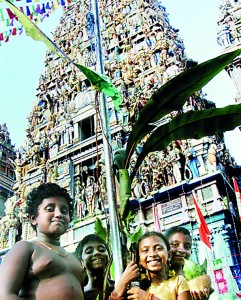The pilgrims’ temple: Shri Arulmihu Sivasubramaniya Swamy Kovil
Arulmihu Sivasubramaniya Swamy Kovil at Kompani Veediya, Colombo 2 has a long history going back to 1822. A Shri Subramaniya Shrine was established by one Periyathamby and others on a land owned by Periyathamby at Dam Street, Colombo. This shrine was known as a pilgrims’ temple because devotees were largely travellers, including those proceeding to Kataragama from the north and the other parts of the island. It was also a place of worship for many officers and men who travelled through Colombo from India to Africa during the Boer War.
The pilgrimage to Kataragama from various parts of the island through Colombo paved the way for the establishment of a number of shrines for Skanda in Colombo which also served as Hindu pilgrims’ rests.
Sir Ponnambalam Arunachalam writing on the importance of the worship of Skanda says –

Devotees at the festival. Pic by Nilan Maligaspe
“More often the Tamils call him by the pure Tamil name Murukan, ‘the tender child’. He is represented in legend, statuary and painting as a beautiful child or youth. The priests worship him with elaborate rites and ceremonies, the rustic with meal and blood offerings, the aboriginal Vedda invokes him also with dances in the primitive manner of the woods. The philosopher meditates on him in silence, adoring him as the Supreme God, Subramanya – the all pervading spirit of the universe, the Essence from which all things are evolved, by which they are sustained and into which they are involved – who in gracious pity for humanity takes form sometimes as the youthful God of Wisdom, God of war when wicked Titans (Asuras) have to be destroyed, sometimes as the holy child Muruka, type of perennial tender beauty, always and everywhere at the service of his devotees.”
Hindus see His Almighty in different forms but a large number of Tamil Hindus have over a period of years chosen to see His Almighty as ‘Muruka’. As the property on which the shrine stood was acquired by the Government, it made a sum of Stg.£ 500 available to Shri Arunasalam Ponnambalam Mudaliyar who was the father of Sir Ponnambalam Arunachalm in or about 1867 to construct a new temple for Shri Sivasubramaniya Swami at another site in Colombo. Thus this temple came to be constructed at Kew Road, Slave Island in 1870 by Shri Arunasalam Ponnambalam Mudaliyar and it was dedicated as ‘Kathiresan Kovil’, Slave Island.
In 1902 Sir Ponnambalam Ramanathan (Sir Arunachalam’s brother) remodelled, enlarged and reconstructed the temple and named it Shri Sivasubramaniya Swamy Kovil. This temple was also under the same management as that of Shri Ponnambaleswara Temple in Kochchikade.
In 1942 a Board of Trustees was constituted to manage this temple and Mr. M.S. Thiruvilangam was the Managing Trustee and Chairman of the Board.
In 1962 it was proposed that the temple should be renovated, but the work commenced later under the Board of Trustees chaired by Mr. V. N. Kanagasabai. Having completed the renovation, a Maha Kumbabishekam (consecration) was held on March 31, 1975.
An 82-foot Rajagopuram (with two manigopurams) were constructed in 1995. Thirukkopura Thiruppani Sabhai headed by Mr. Sinnathurai Dhanabalaa with Secretary, Mr. K.Balasubramaniam spearheaded the efforts.
The observance of Skanthasashdi annually for six days is another important feature of this Kovil’s annual calendar. This year ‘Soorasamkaram’ will take place on Friday, November 8.
The Annual Festival is held regularly in this kovil, commencing with the ‘Kodi Ettam’ and concluding with the ‘Theertham’. The Ther Festival took place on the day before Theertham this year on August 1. ‘Kodi Ettam’ (Flag hoisting) represents the soul’s attempt to ascend to ‘moksham’.
The ‘Ther’ (Chariot) is a symbol of the universe and the four wheels mean ‘Inquire, Investigate, Analyse and Study’.
The ‘Thangathther’ (Golden Chariot) of this kovil was constructed and floated on August 9, 1998 due to the efforts of the committee chaired by Mr. Thirukumar Nadesan with a 21 foot (with a golden umbrella) Ther, adding to the holy significance and veneration of this 188-year-old Kovil. A number of dedicated ‘Thondars’ led by Mr. K. Balasubramaniam supported Mr. Nadesan in his efforts.
Mr. Nadesan who chairs the Board of Trustees of this kovil believes, “Engum Murugan Ellam Murugan Yathum Murugan” (meaning ‘He resides everywhere – He is in everything – He is everything’). This is the ardent belief of every worshipper of this kovil. When these devotees recite ‘Arohara Arohara’ as the Golden Chariot starts rolling on the street, everyone could feel their faith in Lord Murugan who with His six faces and two consorts appear on the chariot to bless His devotees.
(The writer is President, All Ceylon Hindu Congress and Secretary, Board of Trustees of the Kovil)
Follow @timesonlinelk
comments powered by Disqus


